 W
WAcademy Grove Historic District is a national historic district at Upper Fairmount, Somerset County, Maryland, United States. It comprises two Italianate-influenced frame buildings. These include the Fairmount Academy, constructed between 1860 and 1867 to serve as a public school for the Potato Neck District, and the Knights of Pythias Hall, erected adjacent to the Academy about 1872 by the Fairmount Lodge No. 77 of the Knights of Pythias. As early as 1883 the Knights of Pythias Hall was rented by the Board of Education for classroom space; when the Fairmount Lodge disbanded in 1911, the Hall continued to provide additional classroom space for the Academy.
 W
WThe Alabama Penny Savings Bank, at 310 18th St. N in Birmingham, Alabama, was built in 1913. It has also been known as the Pythian Temple. It was listed on the National Register of Historic Places in 1980.
 W
WThe Austin City Hall, at 90 South St. in Austin, Nevada, was built in 1866, when Austin was prosperous as a new silvermining city, and served as a city hall and jail. It has also been known as Austin Station House, as Austin American Legion Hall, and as Austin VFW Hall. It was listed on the National Register of Historic Places in 2003. It was deemed significant for serving Austin during most of the 1864-1881 period during which Austin was legally a city. The building was transferred to the local Knights of Pythias chapter and extended in c.1904; it was bought by the local American Legion chapter in 1947, and, as of 2003, continued to serve as a location for American Legion and for VFW meetings.
 W
WHenry Gassaway Davis House, also known as the Knights of Pythias Lafayette Lodge Number 3 and Calanthe Temple #8 Pythian Sisters, is a historic home located at Piedmont, Mineral County, West Virginia. It was built in 1871, for U.S. Senator and Vice Presidential nominee Henry G. Davis (1823-1916). It is a three bay, four story Second Empire style brick duplex. It has a simple mansard roof and 12 gabled pedimented dormer windows on the concave slopes. The front façade features dual stone and slate stairs, ascending to two centered paired six by nine foot framed one-story entry porches.
 W
WThe Eagle Harbor Schoolhouse is a school located at the corner of Third and Center Streets in Eagle Harbor, Michigan, United States. It is significant as the location where Justus H. Rathbone was first inspired to write the ritual which was the basis of the Order of the Knights of Pythias. The schoolhouse was designated a Michigan State Historic Site in 1971 and listed on the National Register of Historic Places in 1972. It is also known as the Pythian Shrine and as the Rathbone School.
 W
WElks' Lodge No. 468 is a Romanesque-style clubhouse located in Kingman, Arizona. The building is listed on the National Register of Historic Places.
 W
WThe Highlands Masonic Lodge, also known as the Pythian Building, is a historic building located in Denver, Colorado. Built in 1905 and constructed in the Classical Revival style, it was listed on the National Register of Historic Places in 1995.
 W
WThe William Hood House was built in 1858 by William Hood. Its California Historical Landmark number is 692. It was listed on the National Register of Historic Places on February 6, 1998.
 W
WThe Knights of Pythias Building is an historic three-story redbrick Knights of Pythias building located at 315 Main Street in Fort Worth, Texas. Also known as the Knights of Pythias Castle Hall, it was built in 1901 on the site of an 1881 structure, the first Pythian Castle Hall ever built, which had burned earlier the same year. The building housed the city's first offset printing press and coin-operated laundry. On April 28, 1970, it was added to the National Register of Historic Places. The building is also a Recorded Texas Historic Landmark (RTHL). In 1981 it was restored and is now part of the Sundance Square area of downtown Fort Worth. The lead tenant in the building today is Haltom's Jewelers.
 W
WThe Knights of Pythias Building in Phoenix, Arizona, was built in 1928. It has served as a clubhouse and as a specialty store. It was listed on the National Register of Historic Places in 1985.
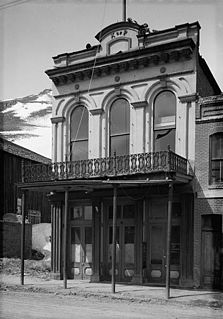 W
WThe Knights of Pythias Building, also known as the Knights of Pythias Hall is an historic Knights of Pythias lodge hall located in Virginia City, Nevada, United States. It was built of cast iron and stuccoed brick in 1876 by Nevada Lodge No. 1 of the Knights of Pythias, which had been formed on March 23, 1873. It was also used the city's other Knights of Pythias lodges: Lincoln Lodge No. 6 formed in 1874, and Triumph Lodge No. 11 formed in 1879. It is one of the few unaltered false-fronted buildings remaining in Virginia City. The Knights of Pythias Building is a contributing property in the Virginia City Historic District which was declared a National Historic Landmark in 1961 and added to the National Register of Historic Places in 1966.
 W
WThe Knights of Pythias Building and Theatre, also known as K. of P. Building, is a historic building located at Greensburg, Decatur County, Indiana. It was built in 1899 by the Knights of Pythias, and is a three-story brick building that includes Early Commercial and Italianate style design elements. A four-story theater was added to the original building in 1908. The theater closed in 1958.
 W
WKnights of Pythias Lodge is a historic Knights of Pythias building located at South Bend, St. Joseph County, Indiana. It was built in 1922, and is a seven-story, Commercial style brick building with terra cotta. The building features applied Classical Revival style design elements.
 W
WThe Knights of Pythias Lodge Hall, also known as Pythian Castle, in Weiser, Idaho is a building built in 1904. It was listed on the National Register of Historic Places in 1976.
 W
WThe Knights of Pythias Pavilion in Franklin, Tennessee, also known as Carlisle House, is a Classical Revival architecture building designed by Henry Gibel and built in 1897. It was listed on the National Register of Historic Places in 1988.
 W
WThe Knights of Pythias Temple is an historic Knights of Pythias building located at 2551 Elm Street in the Deep Ellum neighborhood of Dallas, Texas. Also known as the Union Bankers Building for a later owner, it was designed by African-American architect William Sidney Pittman and opened in 1916.
 W
WThe Knights of Pythias Temple in Louisville, Kentucky, also known as Chestnut Street Branch-Y.M.C.A., was built in 1914–15. It was designed by Henry Wolters. It is a buff-colored brick building with limestone trim.
 W
WOtterburn is a Palladian-influenced Greek Revival plantation house near Bedford in Bedford County, Virginia. The hilltop house was first built in 1828 for Benjamin A. McDonald (1797-1871) and his wife, the former Sally Camm of Lynchburg, and overlooks the Little Otter Creek watershed. Benjamin A. McDonald, a prominent local Whig educated in Scotland, was appointed a local justice of the peace in 1832 and won election as Bedford County's first presiding justice in 1852. Re-elected twice, he served in the county's highest office from 1852 through 1864. His associated plantation in 1825 was 1,651-acre (668 ha), and included a gristmill, sawmill and dependent structures, mostly operated by enslaved labor. At its largest, the associated plantation encompassed about 2,800-acre (1,100 ha) acres, but in modern times includes fewer than 16-acre (6.5 ha) acres. Fire gutted the original house in 1841, and it was reconstructed in the Greek Revival style by 1843, with an unusual transverse hall plan, facade that makes the 2+1⁄2-story structure look only 1+1⁄2 stories, and the addition of a loggia, cross-gable roof with a wrought iron balustrade and Greek Revival detailing. The surviving wash house also dates to this mid-19th-century era. During the Civil War, Union soldiers reportedly confiscated flour barrels from the house, and damaged interior stairwell railings when rolling them out. After McDonald died in 1871, since his only child, a daughter, did not survive infancy, the property passed through several owners until 1950, when the house became the Hines Memorial Pythian Home, an orphanage operated by the Knights of Pythias. A detached dormitory added at this time remains but lacks historic significance. The orphanage closed in the early 1960s. For two years in the late 1960s the Otterburn Academy used the premises, as a private school formed during Virginia's Massive Resistance to desegregation. The property later became a rest home for the elderly. The house is being restored.
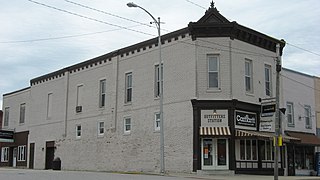 W
WThe Palace Lodge is a historic commercial building in the small town of Winslow, Indiana, United States. Since its construction in the late nineteenth century, the building has been the location of several businesses, the meeting place for two different secret societies, and the center of the town's commercial district. It has been declared a historic site because of its historically significant architecture.
 W
WThe Pigford Building, also known as Pythian Castle Hall, is a three-story red brick building in downtown Meridian, Mississippi. It was listed on the National Register of Historic Places on December 18, 1979.
 W
WThe Pythian Building, completed in 1907, is a Masonic building in Portland, Oregon.
 W
WThe Pythian Castle is a building in Arcata, northwestern California, that was built during 1884-85 for the North Star chapter of the Knights of Pythias fraternal order. It is notable for its commercial Queen Anne style architecture which features five projecting towers: two square towers projecting from the center of the two street-fronting sides of the building, and three round towers projecting from the street-side corners. Patterned shingles covered the tower roofs in the past. The corner ones have "witch hat"-shaped tops and used to sport tall finials. The side ones once had cresting.
 W
WThe Pythian Castle is a historic 3-story brick and stone Knights of Pythias building located at 610-612 Court Street in Portsmouth, Virginia. Built between 1897 and 1898 for the Atlantic Lodge, Knights of Pythias, it was designed by architect Edward Overman in the Romanesque Revival style of architecture. Like many multistory urban fraternal buildings built in the late 19th and early 20th centuries, its street floor was rented out for retail and office spaces while the upper floors were reserved for lodge use. In 1908 a single-story brick and stone Romanesque Revival addition was built to the north of the original building. In 1979 the Pythian Castle was sold by the knights. On October 30, 1980, it was added to the National Register of Historic Places. Today the ground floor is a Mexican eatery.
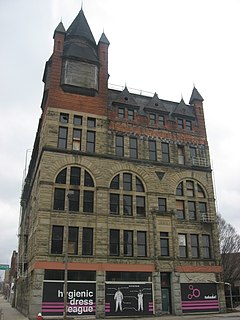 W
WThe Pythian Castle in Toledo, Ohio, is a Romanesque-style building built in 1890. Located in Toledo's Center City at the corner of Jefferson Avenue and N. Ontario Street, it was listed on the National Register of Historic Places in 1972.
 W
WThe Pythian Castle Lodge, also known as Crystal Palace, in Milwaukee, Wisconsin, United States, was built in 1927 by the Knights of Pythias, a fraternal organization. In 1988 it was listed on the National Register of Historic Places.
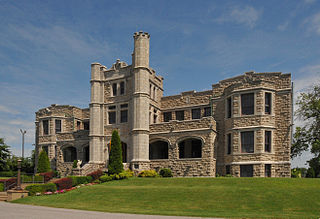 W
WThe Pythian Home of Missouri, also known as Pythian Castle, in Springfield, Missouri, was built in 1913 by the Knights of Pythias and later owned by the U.S. military. German and Italian prisoners-of-war were assigned here during World War II for medical treatment and as laborers. Some prisoners were kept in the detached powerhouse and laundry room behind the castle. The laundry room is still owned by the U.S. Army.
 W
WThe Pythian Opera House, also known historically as the Knights of Pythias Hall, Boothbay Harbor Opera House and The Opera House, and formally as The Opera House at Boothbay Harbor, is a historic meeting hall and multifunction building at 86 Townsend Avenue in Boothbay Harbor, Maine. Built in 1894, it has housed government offices of the town, and the meeting spaces of fraternal organizations, prior to its present use as a performance venue. It was listed on the National Register of Historic Places on December 30, 2008.
 W
WThe Pythian Temple is a historic Knights of Pythias building at 135 West 70th Street between Columbus Avenue and Broadway in the Lincoln Square neighborhood of Manhattan, New York City, in the U.S. state of New York. It was built in 1927 to serve as a meeting place for the 120 Pythian lodges of New York City, and later for many years housed a recording studio. Today it is an 88-unit luxury condominium building known as The Pythian.
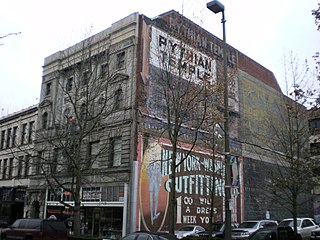 W
WThe Pythian Temple, built in 1906 for Commencement Lodge Number 7 of the Knights of Pythias, is an historic building located on Broadway in the Theater District of Tacoma, Washington. It was designed by noted Tacoma architect Frederick Heath.
 W
WThe Pythian Temple and James Pythian Theater is an historic building in the King-Lincoln Bronzeville neighborhood of Columbus, Ohio. Historically part of the Knights of Pythias, the building was built in 1925 in the Colonial Revival architectural style. It was added to the National Register of Historic Places on November 25, 1983 under the name "York Rite Masonic Temple."
 W
WThe Pythias Lodge Building in San Diego, California, also known as Community Arts Complex or Intercultural Council of the Arts, is a Beaux Arts architecture building built in 1911. It was listed on the National Register of Historic Places in 1981.
 W
WSamuel Starks House is a historic home located at Charleston, West Virginia.
 W
WThe West School is a historic former school in the village of Crooksville, Ohio, United States. Constructed during a period of significant growth in the community, it served local children for a comparatively short time before its sale for private use.
 W
WThe Western Front is an artist-run centre located in Vancouver, British Columbia, Canada. It was founded in 1973 by eight artists who wanted to create a space for the exploration and creation of new art forms. After they purchased the former Knights of Pythias lodge hall located in Mount Pleasant, Vancouver, it quickly became a centre for poets, dancers, musicians and visual artists interested in exploration and interdisciplinary practices. Many of the Western Front's early works reflect this interdisciplinary ethos with early influences of Duchampian and Fluxus-based investigations into mail art, telecommunications art, live electronic music, video and performance art. Western Front also supported a number of political and activist projects - in one of their most famous performance pieces, founding member Vincent Trasov adopted the personality of Mr. Peanut, gave a number of performances and in 1974 ran for mayor of Vancouver. Mr. Peanut was so highly regarded that he was picked by The Vancouver Sun as one of the province's 100 most influential people as the end of the millennium approached in 1999. As a focal point of experimental art practice through the 1970s and 1980s, the Western Front, in connection with other centres like it, played a major role in the development of electronic and networked art forms in a national and international context.